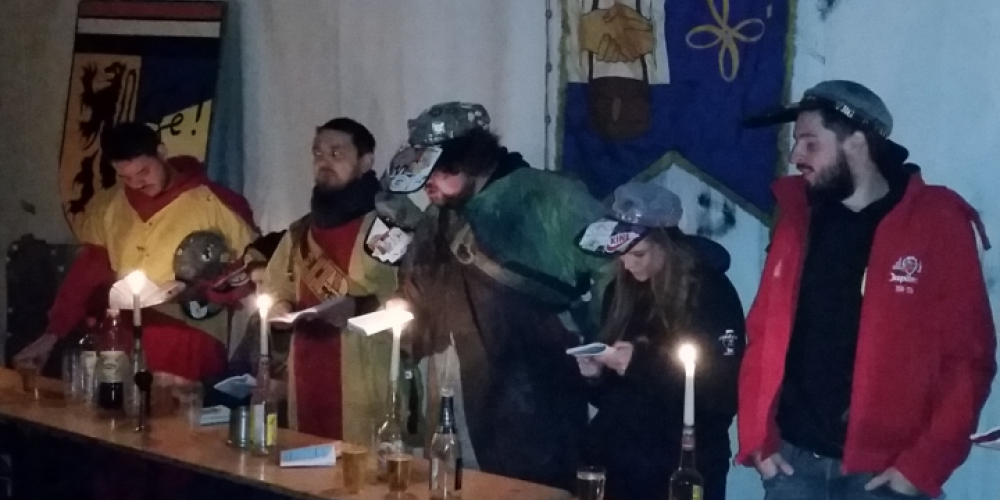
Many of international VUB students may confront a lot of customs, which seem a bit bizarre, especially in this period. To avoid intercultural misunderstandings on general Belgian behaviour and identity, we explain a few key elements to our international audience. If you understand these symbols and rituals in a better way, you may even want to join!
The student cap
Not all Belgians wear a cap with an oversized flap.
The VUB cap may only be worn by students who were baptized in a faculty circle. At the VUB we have 11 of them. On the front the number of stars (for the students of the polytechnic faculty these are replaced by a hexagone) count the number of years one has been a student. On the back of the cap is the symbol of the diploma, the caducé. The band of the cap symbolizes the color of the circle and this band contains the names of all circles in which the owner was initiated. According to the Folklore Academy, a student organization safeguarding these rituals, the triangle on top symbolizes the holy trinity ‘égalité, liberté, fraternité’ from the French Revolution (equality-freedom-brotherhood), the values in which VUB/ULB seek “la vérité” (the truth) through science (Scientia Vincere Tenebras).
Togas and lab coats
Not all Belgians wear dirty gowns.
The custom of wearing long togas comes from science students which continued wearing their lab coats also after practical classes. Gowns or togas are a well-known symbol for high ranking officers such as judges, lawyers, priests… They symbolize power. In student circles only the chairperson, the vice-chairperson and the masters of the initiation are allowed to wear togas. They are better known as the ‘praeses’, ‘vicepraeses’ and ‘doopmeester’. Of those only the praeses wears a ribbon. The praesesses are the only ones allowed to carry on these symbols after they have served their term in function.
Faculty baptism
Not all Belgians are baptized.
To be officially initiated to the student organization and to celebrate being reborn as a student, there is a kind of baptism ritual. After this ritual the student is allowed to carry a cap and lab coat. For faculty circles this includes a (semi)nude theatre which is only accessible for students from VUB/ULB which have been baptized themselves. No outsiders, cameras or mobile phones are allowed. Remember, all newborn babies come naked into this world. During this ritual - in which everybody has to remain sober – the initiates are baptized with a substance called “clash” which varies within the traditions of the different circles. This baptism stands opposed to the traditional religious baptism: it stresses the importance of critical thinking and the principle of free inquiry. It liberates you from any dogmas. It illustrates the equality of all, poor or rich, and defies the often religiously inspired prudery. After the baptism the new members are called commilitones. A few days later they will proudly show their caps in the St-V celebration. The baptism is not compulsory to adhere to a student circle, and is free of choice. Most of the circle activities welcome all students. Regional circles have their own initiations, and a lot of student organisations do not participate in the tradition. There are strong safety and privacy regulations, and the organization is professionally and responsibly led by experienced students.
Saint V or St V
Not all Belgians have a public holiday on the 20th of November.
Pierre-Theodore Verhaegen was the first rector of the ULB, our mother university, which was founded on 20th of November 1834. Also for the independent Dutch-speaking university VUB, Pierre-Theodore Verhaegen is considered as the founding father. On this day, every year over and over again, the academic authorities of both universities and many student representatives make a tour along statues, graveyards and remembrance sites for students and professors killed by oppressors of free speech, such as the Nazi occupiers and the Spanish regime. This is followed by an academic gathering in the city hall of Brussels. Later that afternoon a mass of students of both universities, with and without caps, lab coats or togas, descend from the Grand Sablon to the Bourse, a procession in which student songs and beer prevail. That is the day the students own the city, and once you have assisted one you will always try to be back the next year!
Throughout the remaining months of the academic year, mostly in the second semester, you will probably encounter newly initiated students exercising a novitiate task. Afterwards, they are considered able to ascend to the praesidium, the executive committee of a circle.
Cantus
Not all Belgians like karaoke.
Cantusses are gatherings of students, where they sing student songs. At VUB this is mainly from a book called Codex Studiosorum Bruxellensis. The room is candle-lit and beer flows around, Praeses, Vicepraeses and Cantor sit in front. Cantusses have their own set of rules which decide who sings when. A lot of songs in the traditional VUB songbook are in Dutch and French, but a few English songs are very popular too. With a few beers you will learn how to sing in a foreign language more rapidly and students are always open to songs coming from your own tradition.
At the VUB all recognized circles are represented by the Brussels Studenten Genootschap ‘Geen taal Geen vrijheid’ (Brussels Students Bond ‘No language No Freedom’) shortly BSGgtgv. At the ULB they unite in the ACE, the Association des Cercles d’Etudiants.
If you want to embrace the Brussels way of student life, you will surely enjoy any kind of studentikoziteit elsewhere in the world. You will have learned how to help each other in difficult moments, will learn plenty of songs and will approach the world through undogmatic critical thinking, open eyes and heart and enlightened mind for all and everything you may encounter later in life.